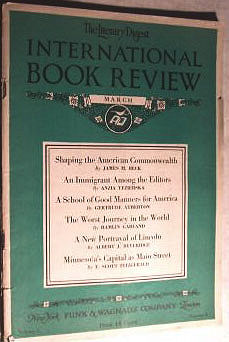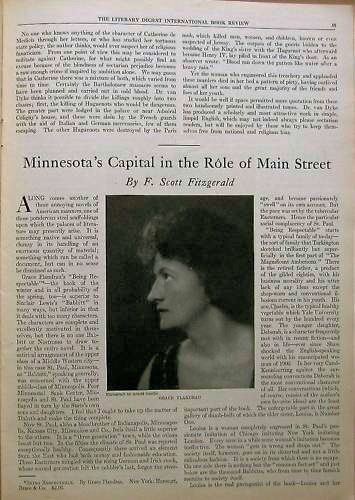
Minnesota’s Capital in the Role of Main Street
by F. Scott Fitzgerald
Along comes another of those annoying novels of American manners, one of those ponderous steel scaffoldings upon which the palaces of literature may presently arise. It is something native and universal, clumsy in its handling of an enormous quantity of material; something which can be called a document but can in no sense be dismissed as such.
Grace Flandrau’s Being Respectable1—the book of the winter and in all probability of the spring, too—is superior to Sinclair Lewis’s Babbitt in many ways, but inferior in that it deals with too many characters. The characters are complete and excellently motivated in themselves, but there is no one Babbitt or Nostromo2 to draw together the entire novel. It is a satirical arraignment of the upper class of a middlewestern city—in this case St. Paul, Minnesota—as Babbitt, speaking generally, was concerned with the upper middle class of Minneapolis. Poor Minnesota! Sauk Center, Minneapolis, and St. Paul have been flayed in turn by the state’s own sons and daughters. I feel that I ought to take up the matter of Duluth and make the thing complete.
Now St. Paul, altho a bloodbrother of Indianapolis, Minneapolis, Kansas City, Milwaukee and Co., feels itself a little superior to the others. It is a “three generation” town, while the others boast but two. In the fifties the climate of St. Paul was reputed exceptionally healthy. Consequently there arrived an element from the East who had both money and fashionable education. These Easterners mingled with the rising German and Irish stock, whose second generation left the cobbler’s last, forgot the steerage, and became passionately “swell” on its own account. But the pace was set by the tubercular Easterners. Hence the particular social complacency of St. Paul.
Being Respectable starts with a typical family of today—the sort of family that Tarkington sketched brilliantly but superficially in the first part of The Magnificent Ambersons. There is the retired father, a product of the gilded eighties, with his business morality and his utter lack of any ideas except the shop-worn and conventional illusions current in his youth. His son, Charles, is the typical healthy vegetable which Yale University turns out by the hundred every year. The younger daughter, Deborah, is a character frequently met with in recent fiction—and also in life—ever since Shaw shocked the English- speaking world with his emancipated woman of 1900. In her very Carol-Kennicotting3 against the surrounding conventions Deborah is the most conventional character of all. Her conversations (which, of course, consist of the author’s own favorite ideas) are the least important part of the book. The unforgetable part is the great gallery of dumb-bells of which the elder sister, Louisa, is Number One.
Louisa is a woman completely engrossed in St. Paul’s passionate imitation of Chicago imitating New York imitating London. Every once in a while some woman’s imitation becomes ineffective. The woman “gets in wrong and drops out.” The society itself, however, goes on in its distorted and not a little ridiculous fashion. It is a society from which there is no escape. On one side there is nothing but the “common fast set,” and just below are the thousand Babbitts, who from time to time furnish recruits to society itself.
Louisa is the real protagonist of the book—Louisa and her young married crowd. They are portraits to the life, differing by less than a hair from each other and from the women on whom they are modeled. They are set down here in all their energy, their dullness, their fear, their boredom— forty well-drest automatons moving with deft, unpleasant gestures through their own private anemic and exclusive Vanity Fair.4 It is a fine accomplishment to have captured them so—with sophistication, satire, occasional bitterness, and a pervading irony.
A thoroughly interesting and capable novel. The writing is solid throughout, and sometimes beautiful. Like Sinclair Lewis and Woodward Boyd, the author has little sense of selection—seems to have poured the whole story out in a flood. The book lacks the careful balance of Three Soldiers, and it is not nearly so successful in handling its three or four protagonists. It skips from character to character in a way that is often annoying. But there it is, the newest and in some ways the best of those amazing documents which are (as Mencken might say) by H. G. Wells out of Theodore Dreiser, and which yet are utterly national and of today. And, when our Conrad or Joyce or Anatole France comes, such books as this will have cleared his way. Out of these enormous and often muddy lakes of sincere and sophisticated observation will flow the clear stream—if there is to be a clear stream at all.
Incidentally, the remarkable portrait of Valeria is the best single instance of artistic power in the book. The entire personality and charm of the woman is conveyed at second-hand. We have scarcely a glimpse of her, and she says only one line throughout. Yet the portrait is vivid and complete.
Notes
1. Flandrau (d. 1971) was a St. Paul novelist.
2. The tide character in Joseph Conrad’s 1904 novel.
3. Carol Kennicott is the protagonist of Sinclair Lewis’s Main Street.
4. Reference to the 1848 satiric novel by English fiction writer William Makepeace Thackeray (1811-1863). Thackeray in turn drew his title—and his conception of the worthlessness of human desires—from “Vanity Fair,” a setting in The Pilgrim’s Progress (1678), a religous allegory by John Bunyan (1628-1688).
Published in The Literary Digest International Book Review magazine (March 1923).
Illustrated by photo-portrait of Grace Flandrau.

